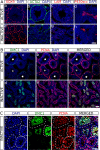Germ cell desquamation-based testis regression in a seasonal breeder, the Egyptian long-eared hedgehog, Hemiechinus auritus
- PMID: 30286149
- PMCID: PMC6171879
- DOI: 10.1371/journal.pone.0204851
Germ cell desquamation-based testis regression in a seasonal breeder, the Egyptian long-eared hedgehog, Hemiechinus auritus
Abstract
Testes of seasonally breeding species experience a severe functional regression before the non-breeding period, which implies a substantial mass reduction due to massive germ-cell depletion. Two alternative mechanisms of seasonal germ-cell depletion have been described in mammals, apoptosis and desquamation (sloughing), but their prevalence has not been determined yet due to reduced number of species studied. We performed a morphological, hormonal, and molecular study of the mechanism of seasonal testicular regression in males of the Egyptian long eared-hedgehog (Hemiechinus auritus). Our results show that live, non-apoptotic, germ cells are massively depleted by desquamation during the testis regression process. This is concomitant with both decreased levels of serum testosterone and irregular distribution of the cell-adhesion molecules in the seminiferous epithelium. The inactive testes maintain some meiotic activity as meiosis onset is not halted and spermatocytes die by apoptosis at the pachytene stage. Our data support the notion that apoptosis is not the major testis regression effector in mammals. Instead, desquamation appears to be a common mechanism in this class.
Conflict of interest statement
The authors have declared that no competing interests exist.
Figures






Similar articles
-
Cellular Modifications in Spermatogenesis during Seasonal Testicular Regression: An Update Review in Mammals.Animals (Basel). 2022 Jun 22;12(13):1605. doi: 10.3390/ani12131605. Animals (Basel). 2022. PMID: 35804504 Free PMC article. Review.
-
Identification of live germ-cell desquamation as a major mechanism of seasonal testis regression in mammals: a study in the Iberian mole (Talpa occidentalis).Biol Reprod. 2013 Apr 18;88(4):101. doi: 10.1095/biolreprod.112.106708. Print 2013 Apr. Biol Reprod. 2013. PMID: 23515671
-
Circannual Testis Changes in Seasonally Breeding Mammals.Sex Dev. 2015;9(4):205-15. doi: 10.1159/000439039. Epub 2015 Sep 17. Sex Dev. 2015. PMID: 26375035 Review.
-
Role of apoptosis and cell proliferation in the testicular dynamics of seasonal breeding mammals: a study in the Iberian mole, Talpa occidentalis.Biol Reprod. 2010 Jul;83(1):83-91. doi: 10.1095/biolreprod.109.080135. Epub 2010 Mar 31. Biol Reprod. 2010. PMID: 20357272
-
The balance between apoptosis and autophagy regulates testis regression and recrudescence in the seasonal-breeding South American plains vizcacha, Lagostomus maximus.PLoS One. 2018 Jan 31;13(1):e0191126. doi: 10.1371/journal.pone.0191126. eCollection 2018. PLoS One. 2018. PMID: 29385162 Free PMC article.
Cited by
-
Comparative evaluation of the ultrastructural morphology and distribution of filiform and fungiform tongue papillae in Egyptian mice, fruit bats and long-eared hedgehogs.Anat Cell Biol. 2020 Dec 31;53(4):493-501. doi: 10.5115/acb.20.173. Anat Cell Biol. 2020. PMID: 33051405 Free PMC article.
-
Cellular Modifications in Spermatogenesis during Seasonal Testicular Regression: An Update Review in Mammals.Animals (Basel). 2022 Jun 22;12(13):1605. doi: 10.3390/ani12131605. Animals (Basel). 2022. PMID: 35804504 Free PMC article. Review.
-
Rate of spermatogenic cell apoptosis in the testis of domestic chicken (Gallus gallus domesticus) at different age groups.Poult Sci. 2025 Apr;104(4):104953. doi: 10.1016/j.psj.2025.104953. Epub 2025 Feb 26. Poult Sci. 2025. PMID: 40031382 Free PMC article.
-
What do we know about blood-testis barrier? current understanding of its structure and physiology.Front Cell Dev Biol. 2023 Jun 15;11:1114769. doi: 10.3389/fcell.2023.1114769. eCollection 2023. Front Cell Dev Biol. 2023. PMID: 37397257 Free PMC article. Review.
-
Blood-Testis Barrier and Sperm Delayed in the Cauda Epididymis of the Reproductively Regressed Syrian Hamsters.Dev Reprod. 2021 Mar;25(1):1-14. doi: 10.12717/DR.2021.25.1.1. Epub 2021 Mar 31. Dev Reprod. 2021. PMID: 33977170 Free PMC article.
References
-
- Neill JD. Knobil and Neill’s physiology of reproduction: Academic Press; 2006. 3296 p.
-
- Dadhich RK, Real FM, Zurita F, Barrionuevo FJ, Burgos M, Jimenez R. Role of apoptosis and cell proliferation in the testicular dynamics of seasonal breeding mammals: a study in the Iberian mole, Talpa occidentalis. Biology of reproduction. 2010;83:83–91. 10.1095/biolreprod.109.080135 . - DOI - PubMed
Publication types
MeSH terms
Substances
LinkOut - more resources
Full Text Sources

